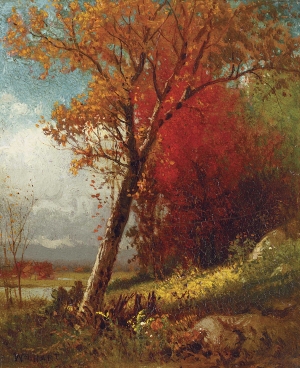
The nineteenth century critic George W. Sheldon spoke to the popularity of William Hart's (1823–1894) cabinet landscapes2 when he observed they "may be found in almost all the principal private collections in the Atlantic cities...These productions always meet with a ready sale. Their author is very industrious and persevering."3 What is notable about this quote is the stir that physically small landscapes created, particularly in relation to the heroic panoramas executed by fellow landscape painters at the time. As art historian Phyllis Peet would later record about William (and his brother James [1828–1901]): "By the late 1850s leading magazines and newspapers reported on the landscape painters William and James Hart as frequently as their famous Hudson River School colleagues, Frederic Church (1826–1900) and Asher B. Durand (1796–1886)."4
William Hart embodied the meaning of Ralph Waldo Emerson's belief: "To be simple is to be great." His compositions relied on a simplicity of elements combined and developed in a variety of ways, so that while the landscapes shared similar content, they were by no means repetitive or formulaic. Sheldon articulated Hart's straightforward schema: "Mr. Hart's landscapes present the sunny and peaceful aspects of Nature—the sylvan stream, the refulgent sunset, pleasant trees, honest cows and lush, green grass."5 Such elements create a calm and pleasant mood, striking a balance between contemplation and elation. As we begin to study these landscapes, their simplicity, variety, and balance become more apparent, as does the artist's technical skill.